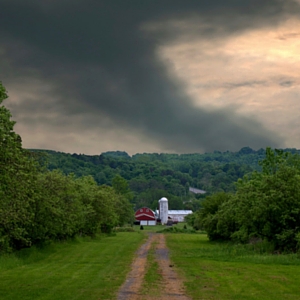Don't Get Blown Away by Tornado Season

Tornadoes can happen in any state, but they tend to hit the Midwest harder than most, and it's usually in the spring. If you live in the Midwest, keep a close eye on the weather in the spring and listen to forecasts and severe weather alerts so you can take cover and stay safe.
What to Look For
Meteorologists do their best to predict severe weather before it strikes, but tornadoes sometimes happen suddenly. Some people ignore the warning sirens and don't take cover, which can be a deadly mistake. If the sirens don't go off, but the weather seems ominous, there are a few things you can look for that indicate conditions are right for a tornado:
- Large hail, followed by an eerie calm
- Greenish-gray, dark skies
- A low-lying, large dark cloud
People who have survived tornadoes report that it sounded like a freight train. At this point, you should have already taken cover.
Where to Go and What to Do
Prior to storm season, make sure your family knows where to go if there's a chance of a tornado. Ideally, you can take cover in a basement or storm cellar during a tornado, just be sure to choose an area that is away from windows. Also be sure to wear sturdy shoes in case you need to navigate through debris after the storm.
If your house doesn't have a basement or storm cellar, or if you are in an apartment or a high-rise building, go to a room on the lowest level of the structure and avoid windows. A bathroom without windows is a good option. If you are in a house without a basement and there's time, bring pillows or even a mattress to shield yourself and your family from falling debris.
Additionally, according to Roy Wright, President and CEO of the Insurance Institute for Business & Home Safety (IBHS), “It’s not uncommon for me to be told 80-85% of catastrophic losses for residential homes start with damage to the roof. Reduce the chance for damage to your roof by closing all the interior doors to compartmentalize pressure in the event wind finds a way into a home through a broken window, compromised garage door, or other opening. Once inside, wind can create strong upward pressure on the roof that will try to pop the roof off. Closing the doors contains Mother Nature’s fury, reduces the upward pressure on the roof, and gives you a better chance of keeping the roof on.”
If you are in a mobile home or office, get to a different shelter as quickly as possible. Mobile buildings do not provide much, if any, protection from tornadoes.
What to Do if You're Driving
If you are driving and tornado sirens go off, the safest thing you can do is get to a sturdy building. Staying in your car is not your best option. An E2 tornado can easily pick up your car and toss it like a baby tosses its rattle. If there's no building around and it's safe to do so, try to get to an area of the ground that is lower than the road. Just be sure to curl up on your knees and cover your head and neck with your hands. A coat or blanket can provide even more protection you against flying debris.
According to the Storm Prediction Center at the National Oceanic and Atmospheric Association (NOAA), if you can see the tornado and it's far away, and you can tell what direction it's moving, you may be able to drive out of its path by moving at right angles to the tornado. If you cannot get out of your vehicle in time, pull over—but not under an overpass. Stay in the car with your seatbelt on, but make sure your head is lower than the windows. Try to cover your head with a coat, blanket or anything that can protect you against flying debris.
After the Storm
If a tornado hits during a time when your family isn't all together, try to have a plan to alert each other that you are okay. Cell phones may or may not work, depending on if the towers were taken down by the tornado and how overloaded they are.
If there's serious damage and a lot of debris, you'll naturally want to try to recover as many things as possible. Just be careful and aware of hazards like broken glass, nails, downed power lines or possible natural gas leaks. Make sure your kids are aware of these hazards too.
If you are a Shelter customer, report your claim at 1-800-SHELTER(743-5837) as soon as you safely can. After catastrophic storms, we try to get on site as soon as possible. In addition to local claims adjusters, we send our Storm Response Team to affected areas so you can file your claim as soon as possible. If you can, try to take pictures of the damage if it is safe to do so, and create a temporary street address sign so our adjusters can find you.
